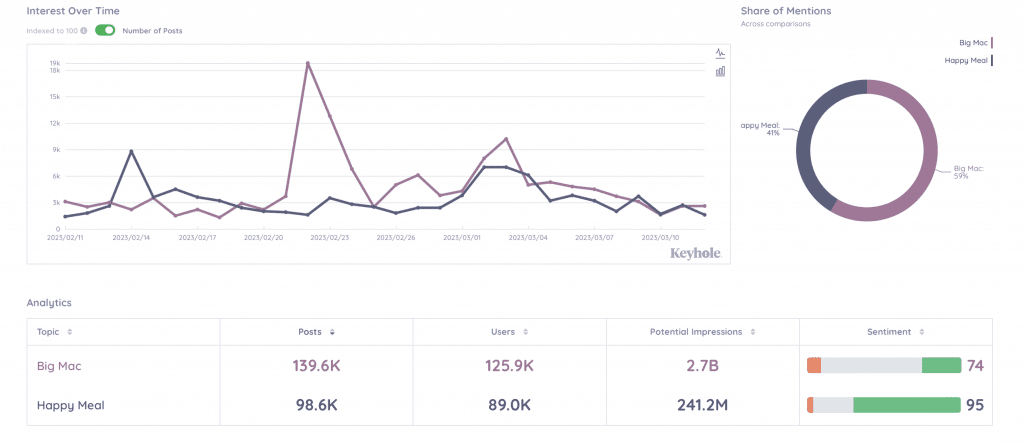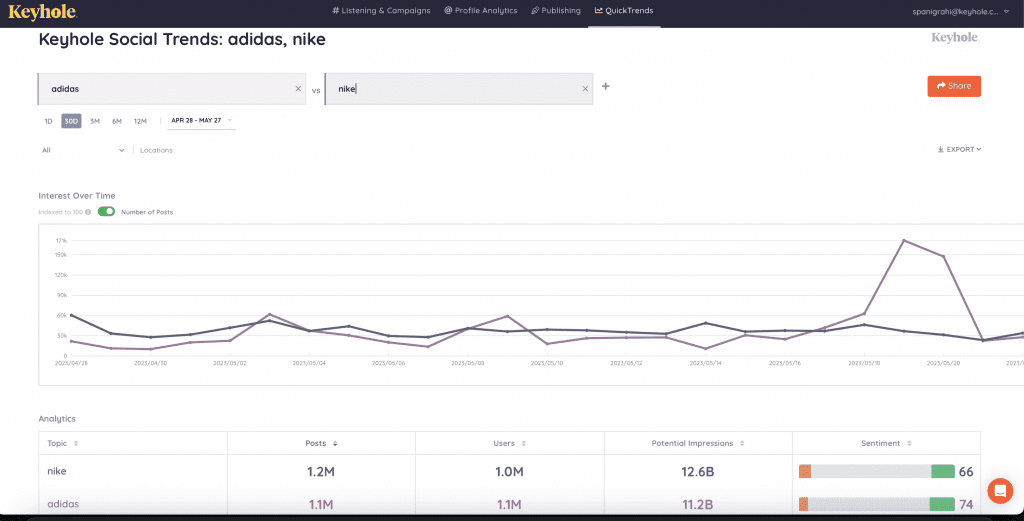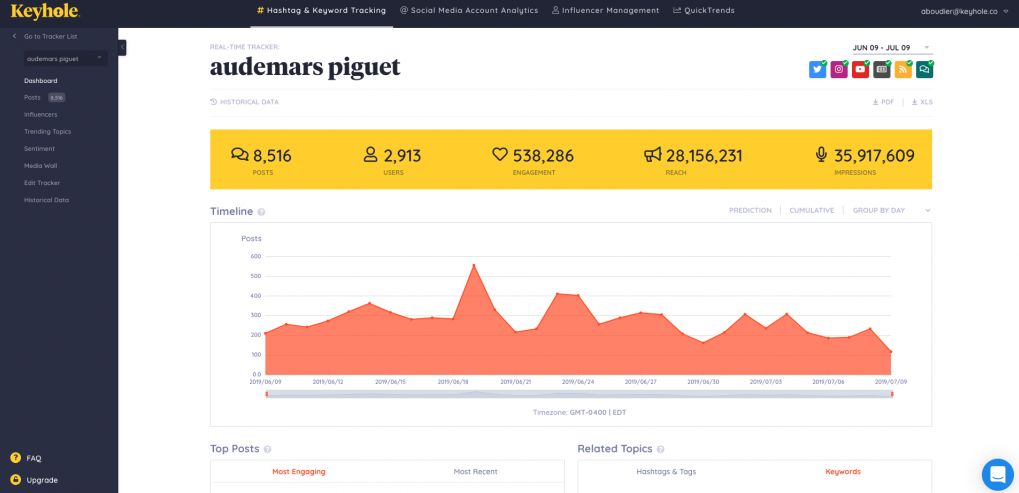Share of voice, also known as SOV, is a unit of measurement to find out how much authority you have when it comes to industry discussions.
It also indicates how often customers turn towards your brand when discussing trends, ideas, and insights in your industry.
If you were to visualize it, it might look something like the market share graphic below:
Table of Contents
Measuring SOV is particularly helpful because it helps you understand exactly where you stand in the industry and how and where you can leverage your voice to make an impact or improve your reputation.
For example, a situation where SOV can be valuable is understanding online conversations around controversial and/or sensitive topics like mental health.
By tracking mentions of Adderall alongside discussions of anxiety or depression, brands can gain valuable insights into public perceptions of mental health solutions. Through this monitoring and research, health brands can better understand effectiveness and potential risks.
And that’s just the tip of the iceberg. Measuring SOV can benefit businesses of all sizes, regardless of industry.
In the case of measuring the share of voice on social media, you can leverage social signals, social listening tools, and brand visibility analytics. But that’s not all you can do.
Without further ado, let’s dive into the meat and potatoes of how to measure the share of voice on social media.
Here are a few SOV metrics worth tracking.
1. Volume of mentions: This share of voice metric indicates the number of times you’ve been tagged in tweets, posts, stories, etc. For example, here’s what a social media mention looks like on X:
2. Social media reach: An indication of how your content is being viewed by a large public (e.g., people from different states/countries, age groups, genders, ethnicities, etc).
3. Other social signals: Other social signals, such as post views, impressions, social media shares, comments, likes, etc., also indicate your share of voice on social media.
At this stage, if you have all the insights you need, you can use the following formula to find your share of voice on social media:
Share of voice formula = Your Brand Metrics / Total Market Metrics
Alternatively, you can leverage social media monitoring or listening tools (like Keyhole) to do the heavy lifting and find your social media SOV.
For example, here’s a screenshot of a social media listening tool analyzing your brand metrics vs. overall market metrics.

Having said that, measuring your impact on social media isn’t all that easy. We say this mainly because we’ve only discussed measuring our SOV with quantitative metrics.
So, let’s take the next section to analyze how to do a complete 360-degree measurement of your share of voice with quantitative and qualitative data.
Here’s the lowdown on properly measuring SOV across all your social media platforms.
1. Competitor analysis
Before we even get to measure our own metrics, we need to analyze what market metrics are, and for that, we need to do a competitive analysis.
How to do that, you ask? It’s simple.
All you need to do is hop onto a social media listening tool. This can be any tool, but our recommendation would be to use the insights of Keyhole.

These tools indicate who your top competitors are. They also show you how you stack up against them (as shown in the visual above).
Ideally, once you have access to these tools, note down the metrics of your top competitors. Try to jot down the metrics of individual companies as well as take an average to see what the industry standard for market presence looks like.
2. Sentiment analysis
If you have the metrics down, the next task is to look at the sentiment around your brand.
We know the saying, “All PR is good PR.” However, a negative mention can severely tank your social media reputation when you’re playing the social media game.
So, always check the conversations surrounding your brand. Are you receiving words of affirmation (like Elf Cosmetics in the above post), or are your customers angry with you (like the image below)?
If you can, try to also analyze other emotions customers have with your brand aside from happy and sad. For example, are they content with your service? Do they find your approach welcoming? Do they trust your brand? Would they recommend you to a friend?
All these things make an impact and eventually help you analyze the vibe you give off to your customers, which will help you rework your communication approach accordingly.
The bottom line is you need to do sentiment analysis to check if your share of voice is positive or negative.
3. SOV Calculations
Lastly, as we previously mentioned, you can use the formula:
Share of voice = Your Brand Metrics / Total Market Metrics
Multiply the output by 100 to arrive at your SOV percentage (%).
Alternatively, if you use social media management tools, the software will directly show you your SOV something like this:
Keyhole: The best tool to help with SOV management

While there are multiple social media monitoring tools in the market, our whole-hearted recommendation would be to move forward with a tool like Keyhole, and here’s why:
- With this tool, you can monitor your brand mentions, keywords, competitor performance, your loyal customers, conversations around your brand, hashtags, etc.
- Not just that, Keyhole is a complete social media management tool. That’s to say, it can help you with brand monitoring. But it can also help you with campaign management, influencer marketing, competitor analysis, market research, etc.
- You can also leverage Keyhole to schedule and publish your posts, give you insights on social media trends, and provide historical data about campaign and profile performance.
Strategies for increasing SOV
Looking for ways to improve your SOV? Here are three simple strategies that you can implement today.
1. Content optimization
For content to perform well on a social media platform, you must optimize it to match the algorithm’s needs.
For example, LinkedIn bumps up content in the algorithm that gives relevant insights and has fresh perspectives.
An HR company, Remote, demonstrates a prime example of using this strategy to its advantage. It uses LinkedIn as the host for a webinar series focused on what’s driving SMBs to hire independent contractors globally.
Posting this webinar on LinkedIn (vs. another social media platform less conducive to this type of content) generated an impressive amount of engagement, with over 200 comments and 170 reactions.
So, how do you follow a similar strategy for your own content? Consider your user requirements. Leverage heatmaps and social media analytics to find which topics do well and how customers engage you with your content.
You’ll end up increasing your SOV as the algorithm will boost your brand’s visibility, and your audience will engage with your content since it’s written/structured the way they want.
2. Engaging content creation
A critical factor contributing to a robust share of voice involves consistently crafting relevant content across various platforms. This entails the creation of high-quality, engaging content designed to resonate with the target audience.
Recess hits the nail on the head by combining eye-catching visuals, giveaways, and helpful tips in their Instagram feed.
Damian Grabarczyk, the co-founder and growth marketer of PetLab Co., says, “In our journey of building social media as a growth channel, we recognized the crucial role of engaging content in amplifying our share of voice on social media.
With over a million followers across platforms, we focused on creating content that engaged and resonated with our audience’s core interests in pet health and wellness. This strategic shift towards content that educates, entertains, and informs has led to a significant increase in our social media influence. It wasn’t just about posting regularly; it was about posting with purpose.
As a result, we saw our messages spread wider, and our community engagement deepened, solidifying our position as a trusted voice in the pet care industry.”
3. Influencer partnerships
Influencer partnerships are, again, an excellent strategy that can help you boost your brand’s visibility.
Experts recommend partnering with different types of influencers for different reasons — for example, you can partner with micro-influencers to boost your brand’s sales or partner with mega-influencers to build your brand’s credibility and increase your visibility.
Try to look for influencers whose content and values closely align with your brand’s values and content. That way, you’ll attract the right audience.
Don’t forget that leveraging influencers can also help improve your SEO score, which can again help boost your brand’s visibility.
Experts recommend asking your influencers to:
- Link to your brand (especially your landing pages) on their own website
- Target long-tail keywords you want to rank for
- Co-write blogs on your website
- Create multi-format content
What’s next?
Just to quickly summarize what we discussed above, here are a few things we should keep in mind:
- You need to track your social media reach, social signals, and brand visibility to analyze your share of voice.
- SOV can clarify where you stand in terms of market discussions and how you can leverage your voice to make an impact.
- You can leverage influencers, optimize content performance, and create engaging content to increase your SOV.
- You’ll likely need a social media monitoring tool to help you properly analyze your SOV.
For the last point, Keyhole could be one of the contenders you can consider to improve your marketing efforts. We already discussed why it’s a helpful tool, so if you’d just like to sign up for it now, then take a 14-day free trial. Don’t worry. We don’t require any credit card information.
Author Bio
Guillaume is a digital marketer focused on handling the outreach strategy at uSERP and content management at Wordable. Outside of work, he enjoys his expat life in sunny Mexico, reading books, wandering around and catching the latest shows on TV.
Related Articles
How To Manage & Improve Online Brand Reputation in 2024 (Guide)
How To Master Brand Sentiment Analysis – Beginner’s Edition
Frequently Asked Questions
1. What is the difference between SOI and SOV?
SOI, also known as Sphere of Influence, is different from SOV, mainly because SOV calculates both qualitative and quantitative metrics, but SOI only considers the quality of brand mentions.
You can calculate the percentage of your share of voice using the share of voice calculation formula: Share of voice = Your Brand Metrics / Total Market Metrics x 100. You can also invest in share of voice tools to measure a variety of marketing metrics to inform your next marketing strategy.
You can use tools like Ahrefs and SEMRush to find out your brand's visibility/rank/organic search for certain topics/keywords and, hence, understand your SEO SOV for that region in this manner.
Yes, but the share of voice can also indicate how likely your audiences are to trust your words or willingly turn toward your brand when it comes to discussing a certain topic.